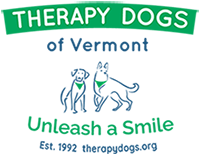– Steve Reiman, Former TDV President and Founder
Are TDV members appreciated in the hospital environment? Dr. Melinda Estes, CEO, Fletcher Allen Health Center, recently asked me to thank all of the therapy dog teams who bring joy to the hospital. “You just can’t imagine how much good your dogs do” she said followed by her big and beautiful smile. Therapy dog visits are beneficial to hospital patients because they bring joy and laughter to people in great need of it. Animals have long been recognized as being a positive force in the healing process. Dogs have a calming and therapeutic effect. They help people cope with the emotional issues related to their illness, loss, or depression. They always invoke pleasant memories of past pets. Best of all, they divert a person’s attention from the pressing problems of the day. Here is what is important when making therapy dog visits in the hospital environment:
In Advance
- Register with the Volunteer Office
- Take hospital’s introductory orientation
- Get current with HIPPA and other required annual training
- Get current with required inoculations
- Obtain a hospital photo ID badge
- Join an established team or check with the TDV liaison to the hospital to start a new team
Before Bringing in Your Dog
- Bathe your dog and trim nails as necessary
- Exercise your dog to burn off excess energy
- Potty your dog as a routine just prior to bringing it on duty
Things to Bring
- Four foot lead, photo ID badge, TDV bandanna
- Plastic bag and paper towels in case of an “accident”
- Anti-bacterial lotion
What to Do at the Hospital
- Sign in upon entering and sign out before leaving
- Visit the floors assigned to your team
- Check in with Charge Nurse on each floor you visit about patients to visit or avoid
- Be mindful of where your dog is at all times (and keep it close to your side)
- Be diligent of isolation signs on patient’s doors
- Ask patients & visitors if they want a visit—some are fearful, others allergic
- Let the patient pat your dog – don’t just show it off unless asked otherwise
- Ask the patient about dogs they have known to stimulate conversation
- Wash hands or use antibacterial lotion after touching a patient
What Not to Do
- Do not assume that a patient likes dogs or even wants a visitor
- Do not let your dog up on the patient’s bed
- Do not allow your dog to jump on a patient even if encouraged to do so
- Do not interfere with hospital staff
- Do not visit wards that are off limits to animals
